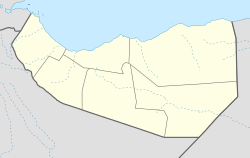This article includes a list of general references, but it lacks sufficient corresponding inline citations. (August 2018) |
God Caanood (Somali: Godcanood) is a town in the Sanaag region of Somaliland. God Caanood (pronounced as God Anood in English) has a ruined old town, according to a scholarly article published by Sada Mire in 2015.[2]
God Caanood | |
|---|---|
Town | |
| Coordinates: 10°6′42″N 47°18′23″E / 10.11167°N 47.30639°E | |
| Country | |
| Region | Sanaag |
| District | Erigavo |
| Population (2002[1]) | |
| • Total | 1,000 |
| Time zone | UTC+3 (EAT) |
| Sada Mire, Mapping the Archaeology of Somaliland: Religion, Art, Script, Time, Urbanism, Trade and Empire, March 2015African Archaeological Review 32(1):111-136 | |
It lies approximately 70 kilometers south of Erigavo. The village is known for its historical significance and its inhabitants are BICIID3, who primarily belong to the MUSE ABOKOR sub-clan of Habar jeclo and t and Magadle clan from Dir tribe.
In terms of livelihood, God Caanood is renowned for its livestock rearing. It holds the distinction of having the highest number of sheep in Somalia, as recorded in the 1970s. Additionally, the village has a strong agricultural tradition.
God Caanood has a rich history, dating back to its establishment in 1950.
It is the very place where Muse abokor received treatments, and where their traditional constitution was documented.
Demographics
editThis town is holy and inhabited by the Muuse Ismaaciil sub-clan of Habar Yoonis and the Muse Abokor Bicide sub-clan of Habar Jeclo.
See also
editReferences
edit- ^ unicef (September 2002). "SANAAG REGION NUTRITION SURVEY REPORT" (PDF). Archived from the original (PDF) on 2021-07-11. Retrieved 2021-07-11.
- ^ Mapping the Archaeology of Somaliland: Religion, Art, Script, Time, Urbanism, Trade and Empire March 2015African Archaeological Review 32(1):111-136
- inhabited the clan habaryoonis [isaaq=-4565051&fid=5787&c=somalia Godanod]
